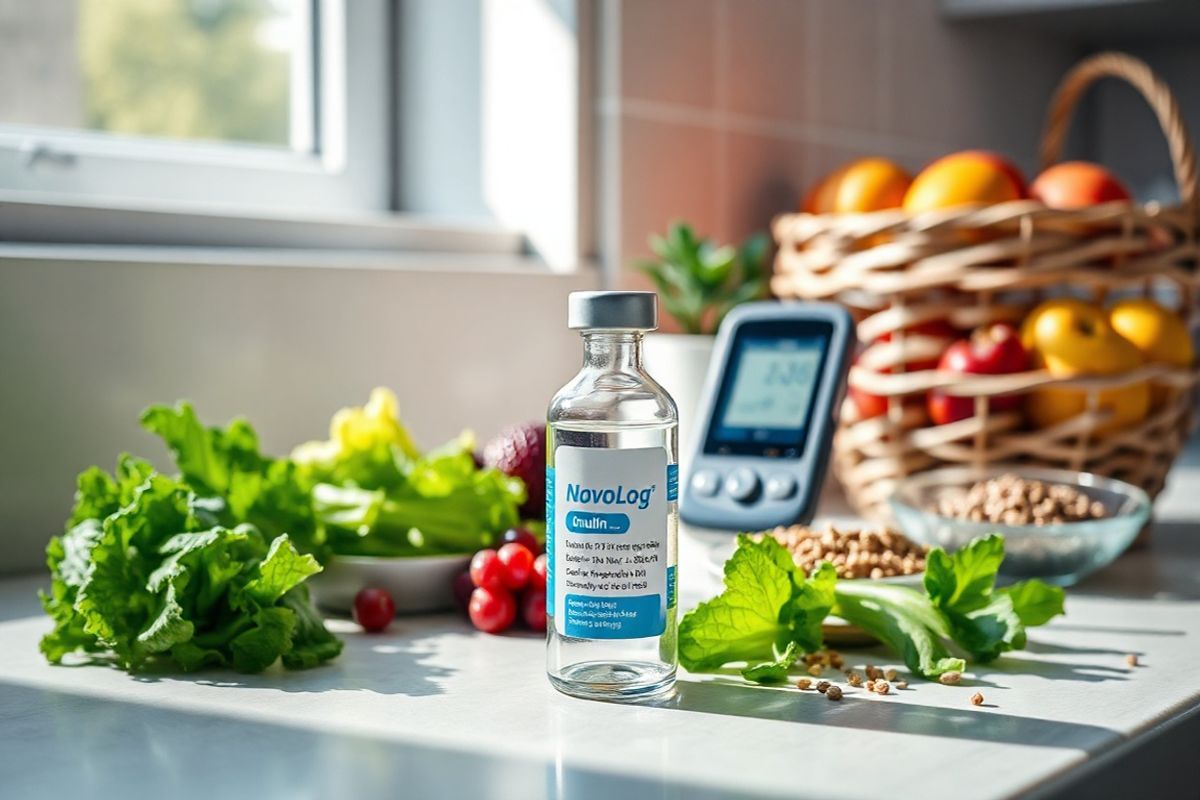Table of Contents
What is NovoLog? An Overview of Its Role in diabetes Treatment

NovoLog is a rapid-acting insulin used primarily for the management of blood glucose levels in people with diabetes. It mimics the natural insulin produced by the pancreas and is particularly effective in controlling postprandial (after-meal) blood sugar spikes. As a fast-acting insulin, NovoLog starts to work approximately 15 minutes after injection, peaks around 1 to 2 hours later, and continues to lower blood sugar for 2 to 4 hours (Healthline, n.d.).
One of the key benefits of NovoLog is its flexibility in dosing, allowing patients to administer it just before meals, which can lead to improved glycemic control compared to other insulins that require earlier administration. It is available in various forms, including vials and prefilled pens, catering to patients’ preferences and lifestyles.
NovoLog is often prescribed as part of a comprehensive diabetes treatment plan, which may include other medications, lifestyle modifications, and regular monitoring of blood glucose levels. Understanding how NovoLog works and its pharmacokinetics is essential for effective diabetes management.
Key Interactions: How NovoLog Works with Other Medications and Supplements

The effectiveness of NovoLog can be influenced by various interactions with other medications and supplements. It is crucial for patients to inform their healthcare providers about all medicines they are taking, including over-the-counter drugs and supplements.
1. Oral Antidiabetic Drugs
NovoLog is frequently used in conjunction with oral antidiabetic medications. For instance, when combined with metformin, it can enhance glycemic control by addressing different physiological mechanisms of diabetes (Cleveland Clinic, n.d.). Metformin decreases hepatic glucose production and increases insulin sensitivity, while NovoLog provides the necessary insulin for effective glucose utilization.
2. DPP-4 Inhibitors and GLP-1 Receptor Agonists
Dipeptidyl peptidase-4 (DPP-4) inhibitors, such as sitagliptin (Januvia), can be prescribed with NovoLog to further control blood sugar levels without significant risk of hypoglycemia. These medications work by prolonging the action of incretin hormones, which stimulate insulin release in response to meals (Mayo Clinic, n.d.).
Combining NovoLog with glucagon-like peptide-1 (GLP-1) receptor agonists can also provide synergistic benefits. These medications not only lower blood glucose but may also promote weight loss, which is advantageous for many patients with type 2 diabetes.
3. SGLT2 Inhibitors
Sodium-glucose cotransporter-2 (SGLT2) inhibitors, such as canagliflozin (Invokana) and empagliflozin (Jardiance), can be effectively combined with NovoLog. These drugs help lower blood glucose by preventing the reabsorption of glucose in the kidneys, resulting in its excretion through urine (CDC, n.d.). The combination may lead to improved overall glycemic control and weight management.
4. Potential Drug Interactions
Certain medications may negatively impact NovoLog’s effectiveness or increase the risk of adverse effects. For example, corticosteroids can elevate blood glucose levels, leading to a potential need for increased insulin doses (Healthline, n.d.). Additionally, other medications that may affect blood glucose levels, such as beta-blockers or thiazide diuretics, should be closely monitored.
5. Supplements and Herbal Products
Patients should exercise caution with supplements and herbal products, as some can affect blood glucose levels. For instance, supplements containing chromium or alpha-lipoic acid may enhance insulin sensitivity, but their effects when combined with NovoLog are not well-studied, necessitating careful monitoring (Healthline, n.d.).
Navigating Diabetes Medications: Combining NovoLog with Other Treatments
Combining NovoLog with other diabetes medications requires careful consideration of individual patient factors, including the type of diabetes, comorbid conditions, and overall treatment goals.
1. Individualized Treatment Plans
Each diabetes patient is unique, and their treatment plan should reflect their specific needs. Healthcare providers must evaluate the patient’s current medications, lifestyle, and response to therapy to develop an effective regimen.
2. Monitoring Blood Sugar Levels
Regular monitoring of blood glucose levels is critical when using NovoLog alongside other diabetes medications. Patients should keep a log of their blood sugar readings to identify patterns and adjust their insulin doses as needed, especially in response to changes in diet, exercise, or medication regimens.
3. Educating Patients on Injection Techniques
Proper injection techniques and sites are essential for optimizing NovoLog’s effectiveness. Patients should be educated on rotating injection sites to reduce the risk of lipodystrophy and to ensure consistent absorption of insulin.
4. Creating a Support System
Support from healthcare providers, diabetes educators, and support groups can significantly enhance a patient’s ability to manage multiple medications and adhere to their treatment plan. Continuous education about diabetes management can empower patients to make informed decisions about their care.
The Importance of Monitoring: Managing Side Effects and Drug Interactions with NovoLog
Monitoring is a fundamental aspect of diabetes management, especially when utilizing insulin therapies like NovoLog. Patients need to be aware of potential side effects and interactions to manage their diabetes effectively.
1. Identifying Side Effects
Common side effects of NovoLog include hypoglycemia, injection site reactions, and, in rare cases, allergic reactions. Patients should be educated on recognizing symptoms of hypoglycemia, such as sweating, trembling, and confusion, and have a plan in place for treatment (Mayo Clinic, n.d.).
2. Regular Medical Check-ups
Regular check-ups with healthcare providers are essential for monitoring the effectiveness of NovoLog and other medications. These visits allow for adjustments to the treatment plan based on the patient’s blood glucose levels and overall health.
3. Utilizing Technology
Advancements in diabetes technology, such as continuous glucose monitors (CGMs) and insulin pumps, can aid in tracking blood sugar levels and adjusting insulin doses more precisely. Patients should be encouraged to utilize these technologies if available.
4. Managing Comorbidities
Patients with diabetes often have comorbid conditions that can complicate treatment. Regular screenings for conditions such as hypertension, dyslipidemia, and depression are vital to provide comprehensive care and improve patient outcomes.
Tips for Effective Use: Maximizing the Benefits of NovoLog in Your Diabetes Care Plan
To make the most of NovoLog in a diabetes care plan, patients should consider the following strategies:
1. Adhere to a Structured Meal Plan
A well-balanced meal plan that aligns with the timing of NovoLog injections can optimize blood sugar control. Patients should work with a registered dietitian to develop an individualized nutrition plan.
2. Engage in Regular Physical Activity
Regular exercise can enhance insulin sensitivity and aid in blood glucose management. Patients should be encouraged to incorporate physical activity into their daily routine while being mindful of the timing of their NovoLog doses.
3. Educate Yourself About Diabetes Management
Knowledge is power. Patients should take the initiative to learn about their condition, diabetes medications, and how to manage their diabetes effectively. This includes understanding the role of NovoLog and how it interacts with other medications.
4. Establish a Routine
Creating a consistent routine for taking medications, monitoring blood glucose levels, and planning meals and activities can significantly improve diabetes management. Consistency helps to stabilize blood glucose levels and reduces the risk of complications.
5. Seek Support
Support from family, friends, and diabetes support groups can provide motivation and encouragement. Engaging with others who understand the challenges of diabetes management can foster a sense of community and shared experience.
FAQ Section
What should I do if I miss a dose of NovoLog?
If you miss a dose of NovoLog, take it as soon as you remember unless it’s almost time for your next dose. Do not double up on doses. Always consult your healthcare provider for specific guidance.
Can I take NovoLog if I am pregnant?
NovoLog can be used during pregnancy, but it’s crucial to consult with your healthcare provider to ensure proper management of blood glucose levels during this time.
How do I store NovoLog?
NovoLog should be stored in the refrigerator before opening. Once opened, it can be kept at room temperature for up to 28 days. Avoid exposing it to extreme temperatures.
Are there any alternatives to NovoLog?
Yes, there are several alternatives to NovoLog, including other rapid-acting insulins like insulin lispro (Humalog) and inhaled insulin (Afrezza). Discuss with your healthcare provider which option may be best for you.
What are the signs of hypoglycemia?
Signs of hypoglycemia include sweating, shaking, confusion, dizziness, and irritability. It’s important to treat low blood sugar promptly by consuming fast-acting carbohydrates, such as glucose tablets or juice.
References
- CDC. (n.d.). Use of New Diabetes Medicines. Retrieved from https://www.cdc.gov/diabetes/data-research/research/new-diabetes-medicines.html
- Cleveland Clinic. (n.d.). Diabetes treatment: Medications for type 2 diabetes. Retrieved from https://www.mayoclinic.org/diseases-conditions/type-2-diabetes/in-depth/diabetes-treatment/art-20051004
- Healthline. (n.d.). List of Common Diabetes Medications. Retrieved from https://www.healthline.com/health/diabetes/medications-list
- Mayo Clinic. (n.d.). Diabetes & Oral Medication: Types & How They Work. Retrieved from https://my.clevelandclinic.org/health/articles/12070-oral-diabetes-medications
- Healthline. (n.d.). Insulin, Medicines, & Other Diabetes Treatments. Retrieved from https://www.niddk.nih.gov/health-information/diabetes/overview/insulin-medicines-treatments











